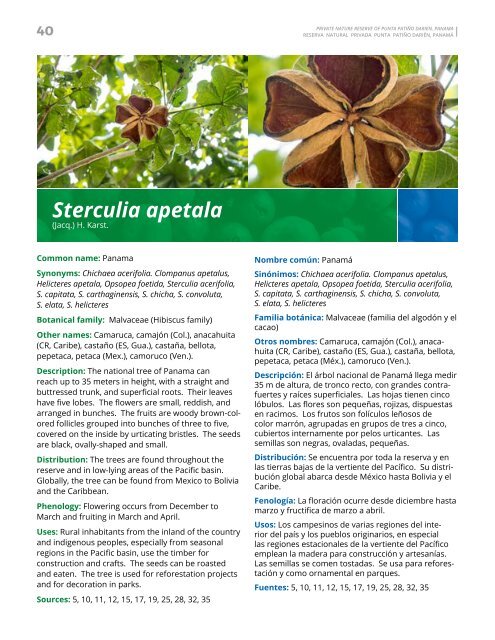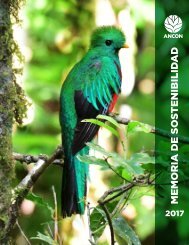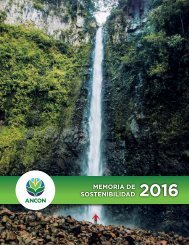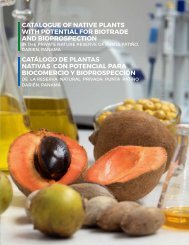Create successful ePaper yourself
Turn your PDF publications into a flip-book with our unique Google optimized e-Paper software.
40<br />
PRIVATE NATURE RESERVE OF PUNTA PATIÑO DARIEN, PANAMA<br />
RESERVA NATURAL PRIVADA PUNTA PATIÑO DARIÉN, PANAMÁ<br />
Sterculia apeta<strong>la</strong><br />
(Jacq.) H. Karst.<br />
Common name: Panama<br />
Synonyms: Chichaea acerifolia. Clompanus apetalus,<br />
Helicteres apeta<strong>la</strong>, Opsopea foetida, Sterculia acerifolia,<br />
S. capitata, S. carthaginensis, S. chicha, S. <strong>con</strong>voluta,<br />
S. e<strong>la</strong>ta, S. helicteres<br />
Botanical family: Malvaceae (Hibiscus family)<br />
Other names: Camaruca, camajón (Col.), anacahuita<br />
(CR, Caribe), castaño (ES, Gua.), castaña, bellota,<br />
pepetaca, petaca (Mex.), camoruco (Ven.).<br />
Description: The national tree of Panama can<br />
reach up to 35 meters in height, with a straight and<br />
buttressed trunk, and superficial roots. Their leaves<br />
have five lobes. The flowers are small, reddish, and<br />
arranged in bunches. The fruits are woody brown-colored<br />
follicles grouped into bunches of three to five,<br />
covered on the insi<strong>de</strong> by urticating bristles. The seeds<br />
are b<strong>la</strong>ck, ovally-shaped and small.<br />
Distribution: The trees are found throughout the<br />
reserve and in low-lying areas of the Pacific basin.<br />
Globally, the tree can be found from Mexico to Bolivia<br />
and the Caribbean.<br />
Phenology: Flowering occurs from December to<br />
March and fruiting in March and April.<br />
Uses: Rural inhabitants from the in<strong>la</strong>nd of the country<br />
and indigenous peoples, especially from seasonal<br />
regions in the Pacific basin, use the timber for<br />
<strong>con</strong>struction and crafts. The seeds can be roasted<br />
and eaten. The tree is used for reforestation projects<br />
and for <strong>de</strong>coration in parks.<br />
Sources: 5, 10, 11, 12, 15, 17, 19, 25, 28, 32, 35<br />
Nombre común: Panamá<br />
Sinónimos: Chichaea acerifolia. Clompanus apetalus,<br />
Helicteres apeta<strong>la</strong>, Opsopea foetida, Sterculia acerifolia,<br />
S. capitata, S. carthaginensis, S. chicha, S. <strong>con</strong>voluta,<br />
S. e<strong>la</strong>ta, S. helicteres<br />
Familia botánica: Malvaceae (familia <strong>de</strong>l algodón y el<br />
cacao)<br />
Otros nombres: Camaruca, camajón (Col.), anacahuita<br />
(CR, Caribe), castaño (ES, Gua.), castaña, bellota,<br />
pepetaca, petaca (Méx.), camoruco (Ven.).<br />
Descripción: El árbol nacional <strong>de</strong> Panamá llega medir<br />
35 m <strong>de</strong> altura, <strong>de</strong> tronco recto, <strong>con</strong> gran<strong>de</strong>s <strong>con</strong>trafuertes<br />
y raíces superficiales. Las hojas tienen cinco<br />
lóbulos. Las flores son pequeñas, rojizas, dispuestas<br />
en racimos. Los frutos son folículos leñosos <strong>de</strong><br />
color marrón, agrupadas en grupos <strong>de</strong> tres a cinco,<br />
cubiertos internamente por pelos urticantes. Las<br />
semil<strong>la</strong>s son negras, ova<strong>la</strong>das, pequeñas.<br />
Distribución: Se encuentra por toda <strong>la</strong> reserva y en<br />
<strong>la</strong>s tierras bajas <strong>de</strong> <strong>la</strong> vertiente <strong>de</strong>l Pacífico. Su distribución<br />
global abarca <strong>de</strong>s<strong>de</strong> México hasta Bolivia y el<br />
Caribe.<br />
Fenología: La floración ocurre <strong>de</strong>s<strong>de</strong> diciembre hasta<br />
marzo y fructifica <strong>de</strong> marzo a abril.<br />
Usos: Los campesinos <strong>de</strong> varias regiones <strong>de</strong>l interior<br />
<strong>de</strong>l país y los pueblos originarios, en especial<br />
<strong>la</strong>s regiones estacionales <strong>de</strong> <strong>la</strong> vertiente <strong>de</strong>l Pacífico<br />
emplean <strong>la</strong> ma<strong>de</strong>ra <strong>para</strong> <strong>con</strong>strucción y artesanías.<br />
Las semil<strong>la</strong>s se comen tostadas. Se usa <strong>para</strong> reforestación<br />
y como ornamental en parques.<br />
Fuentes: 5, 10, 11, 12, 15, 17, 19, 25, 28, 32, 35








